Things to do in Skopje, the weird, wonderful and quirky city that you’ll either love or hate!
A controversial and not to mention very expensive renovation programme has turned this once relatively quiet former Yugoslavian city into a neoclassical masterpiece. Launched in 2010, Skopje 2014, to give the project its correct title, was a government-backed initiative aimed at giving Skopje a more classical appeal (with the hope of attracting more tourists) and the Macedonian people a sense of national identity.

I can understand the ideology behind it; no doubt the Macedonians get fed up to the back teeth with people thinking their country is part of Greece and after the breakup of Yugoslavia, creating a national identity must have seemed like the right thing to do. But boy, did the government take it to another level. An abundance of ‘ancient’ bridges, statues and stately buildings make you feel like you have walked onto the film set of Troy or if I’m being unkind, Meet the Spartans. Skopje is historicist kitsch at its very best and for many Macedonians (including the friendly woman we spoke to at the tourist board), the money spent on the project could have been better used elsewhere (*).
(*) Apparently nobody really knows how much money has been spent on Skopje 14. Estimates range from 200 to 500 million euros and to rub salt in the wound for those who think it is a huge waste of money, a year or so after the grand unveiling of the newly spruced Macedonian Square, it was decided it would be a good idea to dig it all up and redesign it once more (see the photo below).
That’s not to say that we didn’t like Skopje. In fact, we loved it. With the camera snapping ten to the dozen, we spent a few days wandering around the city, marvelling at statues of Macedonian heroes (and possibly a few borrowed Greek ones!) encircled by over the top fountains and monumental faux-classical buildings that some locals don’t even know exist (*).
(*) Again the nice lady at the tourist board. When we asked her to identify a couple of buildings on our camera that were not pinpointed on our map, she gave us a look of frustration and said that buildings were going up all the time and it was impossible to keep track of them all!
All this classical nod to the past nearly distracts from Skopje’s other attractions. For starters, there’s the city’s Old Bazaar, the largest in the Balkans outside of Istanbul, a pleasant hilltop fortress with great views and interesting memorabilia associated with Mother Teresa who was born in the city and lived in Macedonia for about eighteen years before moving away. Add tasty food, a lively outdoor café and bar culture and very cheap beer and you’re onto a winner!
Self-Guided Walking tour of Skopje (4-6 hours)
Skopje is easy to navigate on foot but for easy reference, we have marked the main things to do in Skopje on a Google map:
The best place to start is the Porta Macedonia, a large triumphal arch on Pella Square. Before heading to the big hitters on the Vardar River, however, take a slight detour east to see the Monument to Fallen Heroes for Macedonia and the Monument of the Defenders of Macedonia, which are located in the small Žena Borec Park. The Monument of the Defenders of Macedonia is topped with four golden horses rearing on their hind legs and fronted by a very camp-looking golden male holding a golden torch. The whole thing is, well, very golden, and I should also mention the golden angel complete with golden wings who stands next to the four golden horses!
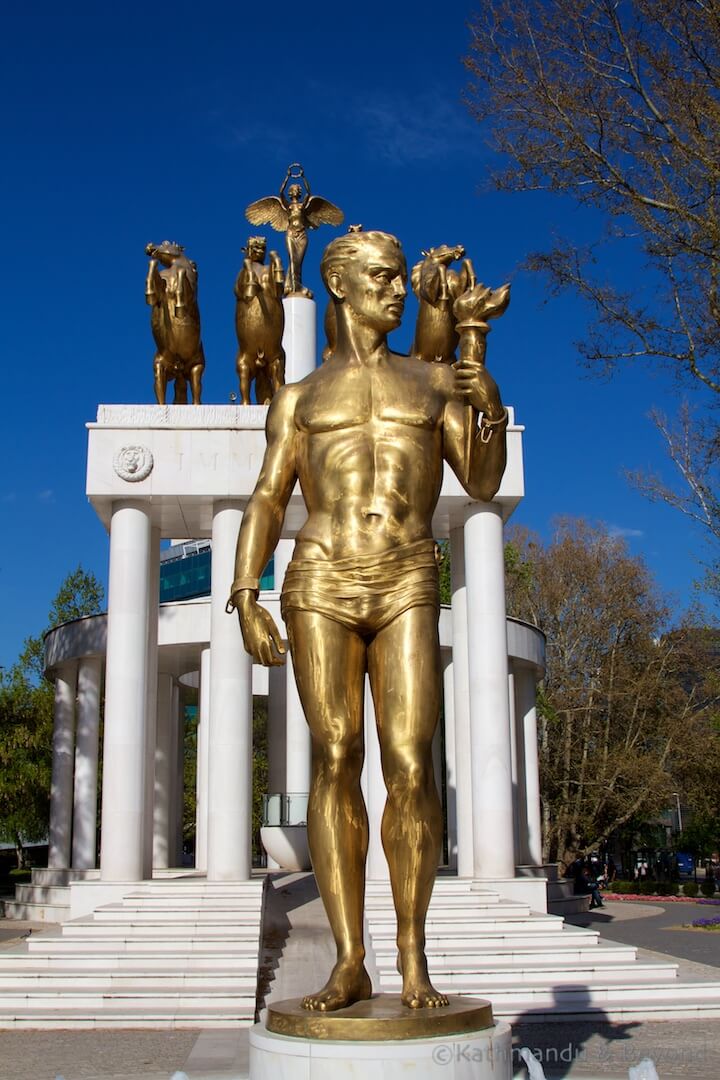
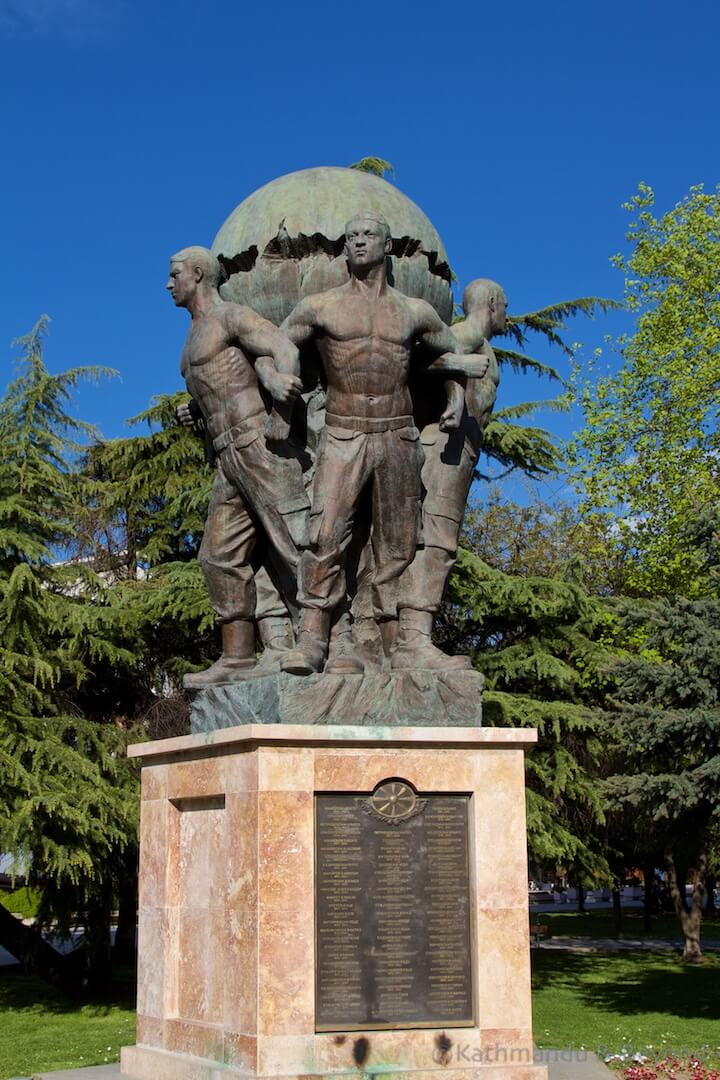
The Monument to Fallen heroes for Macedonia (left) and the Monument of the Defenders of Macedonia (right)
From here it’s a minute’s walk to Macedonian Square. If the powers that be are not still knocking it down and rebuilding it again, which they were doing when we were there in April 2015, then check out the multitude of statues dedicated to national heroes, including the resplendent Warrior on a Horse before strolling the short distance to the riverfront.
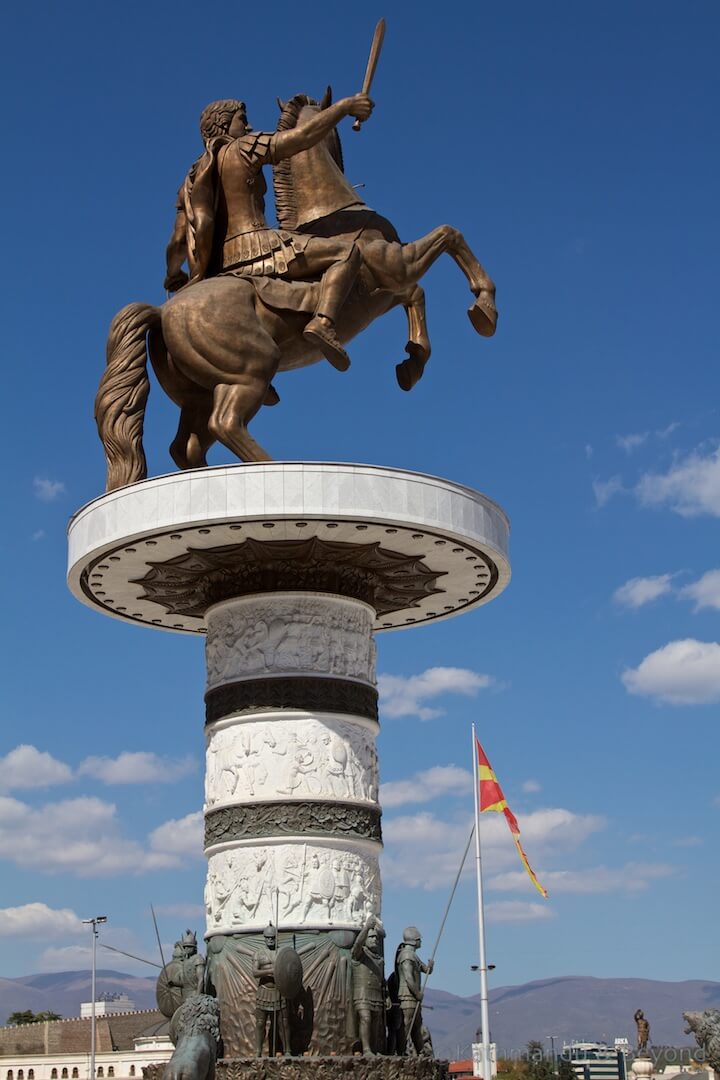
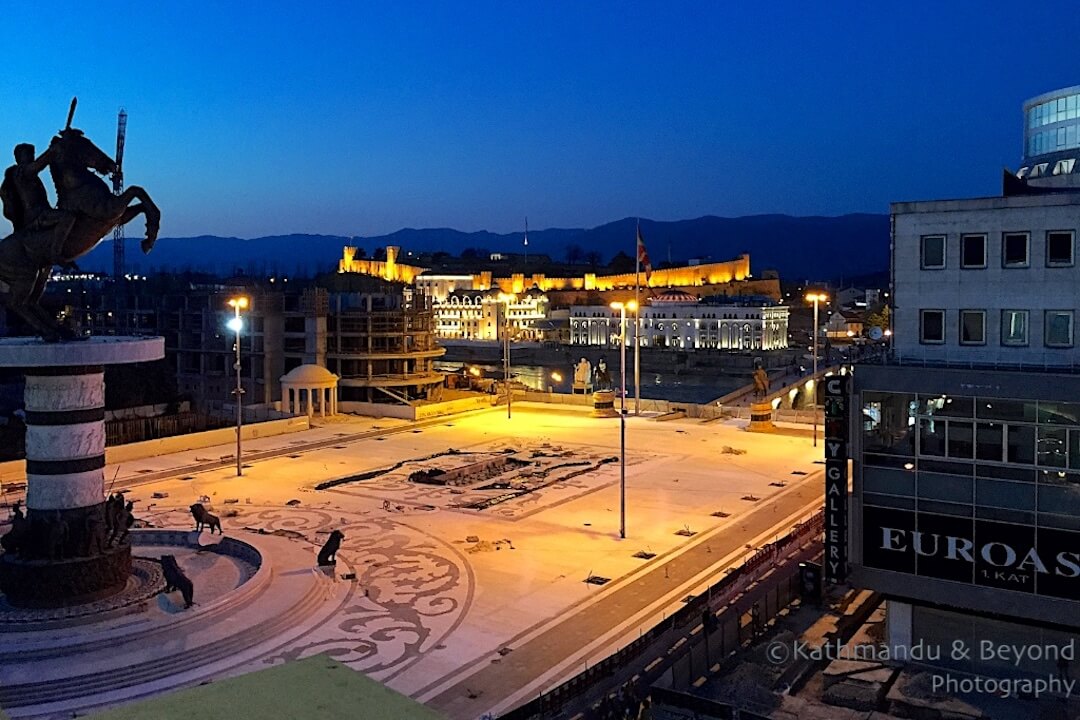
Macedonian Square
Get ready for an architectural smack in the chops as you next step onto the Bridge of Civilisations. Keeping an eye out for passing chariots and Aristotle-types in togas, pause and take stock of the gargantuan buildings before you.
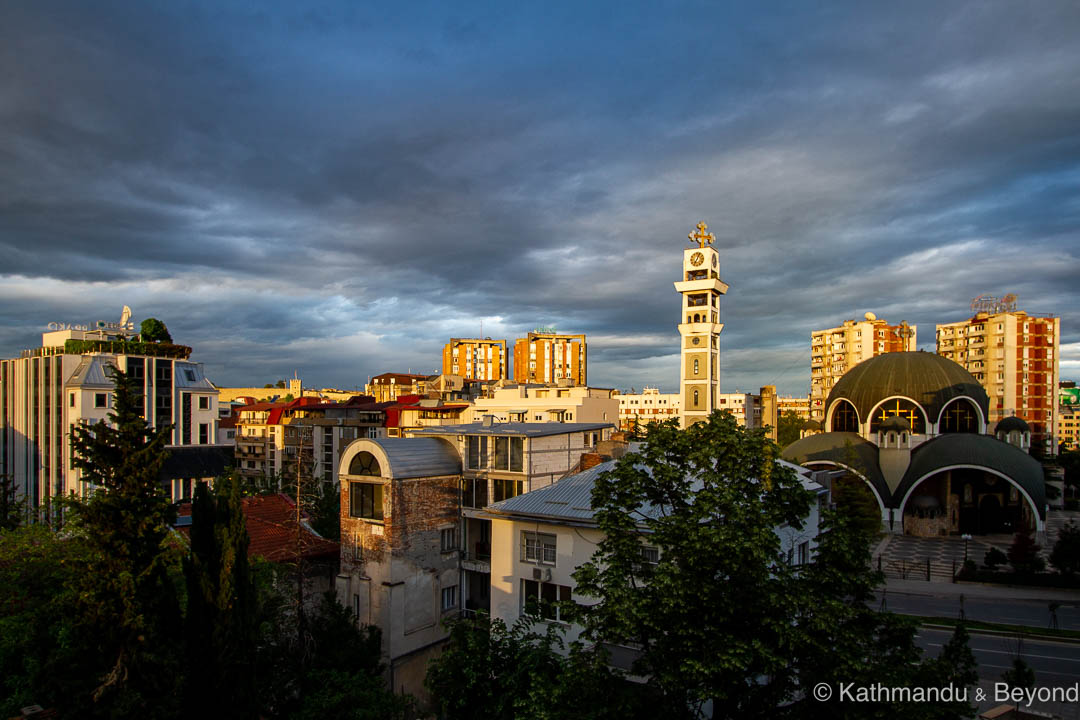 Skopje in the late afternoon
Skopje in the late afternoon
The Archaeological Museum is one of the most impressive of all the buildings lining the north bank of the Vardar River, but there are several more of a similar ilk. I particularly liked the skinny Agency for Electronic Communications building.
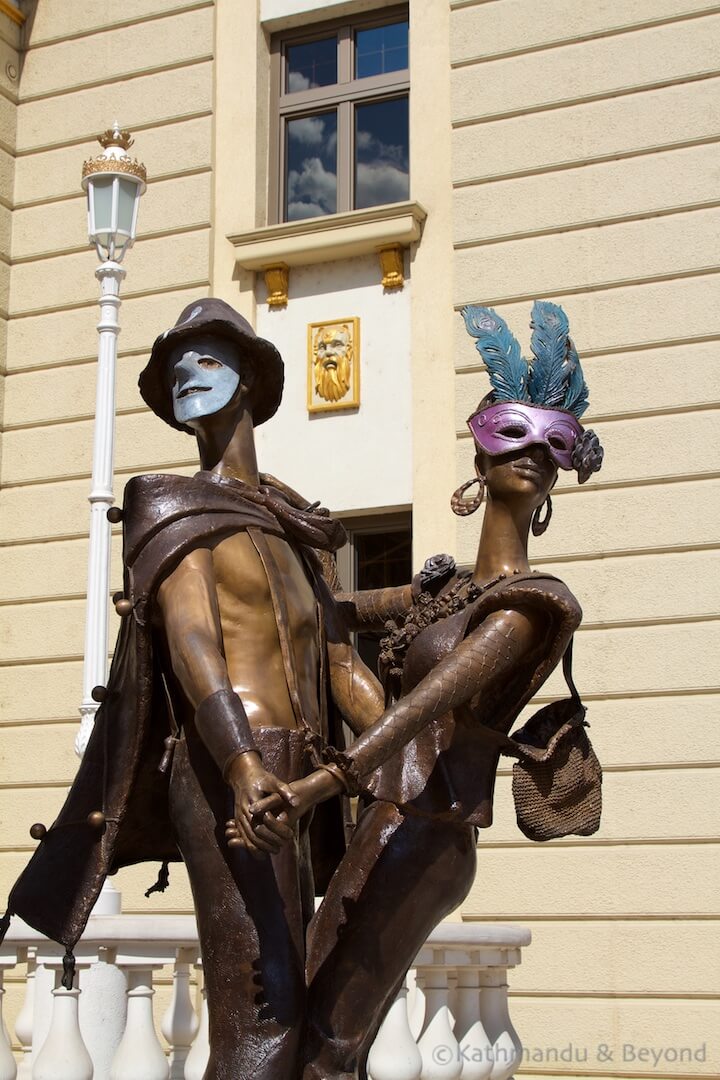
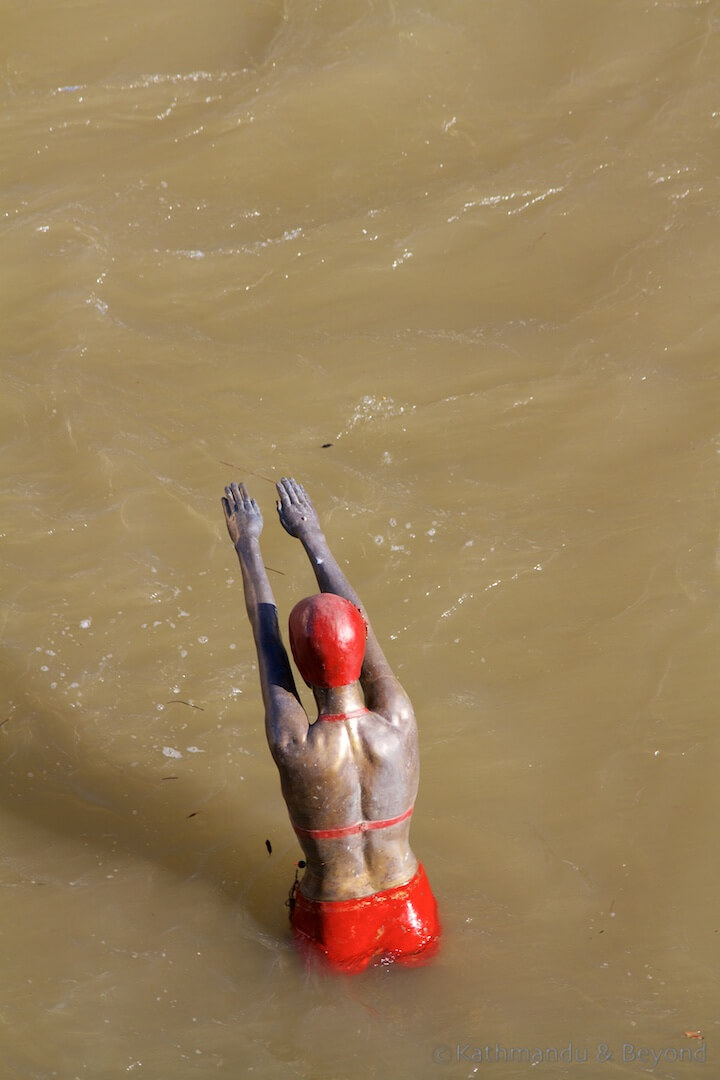
The Macedonian National Theatre (left) and Vardar River (right)
Cross over the bridge and take a short detour to your left to see the Macedonian National Theatre and the Museum of the Macedonian Struggle. Go inside the museum if so inclined before coming to Karpos’s Rebellion Square. The centre of the square is the Warrior monument. Surrounded by an all-singing, all-dancing and very colourful water fountain, the statue is officially named ‘warrior’, but it is generally considered to be a depiction of Alexander the Great’s father, Philip II of Macedon. Denting the country’s coffers by the princely sum of 7.5 million euros, the statue is one of the most photographed sculptures in Skopje.
Karpos’s Rebellion Square serves as a main entrance to the Čaršija neighbourhood and the city’s Old Bazaar and it’s the obvious place to head to next.
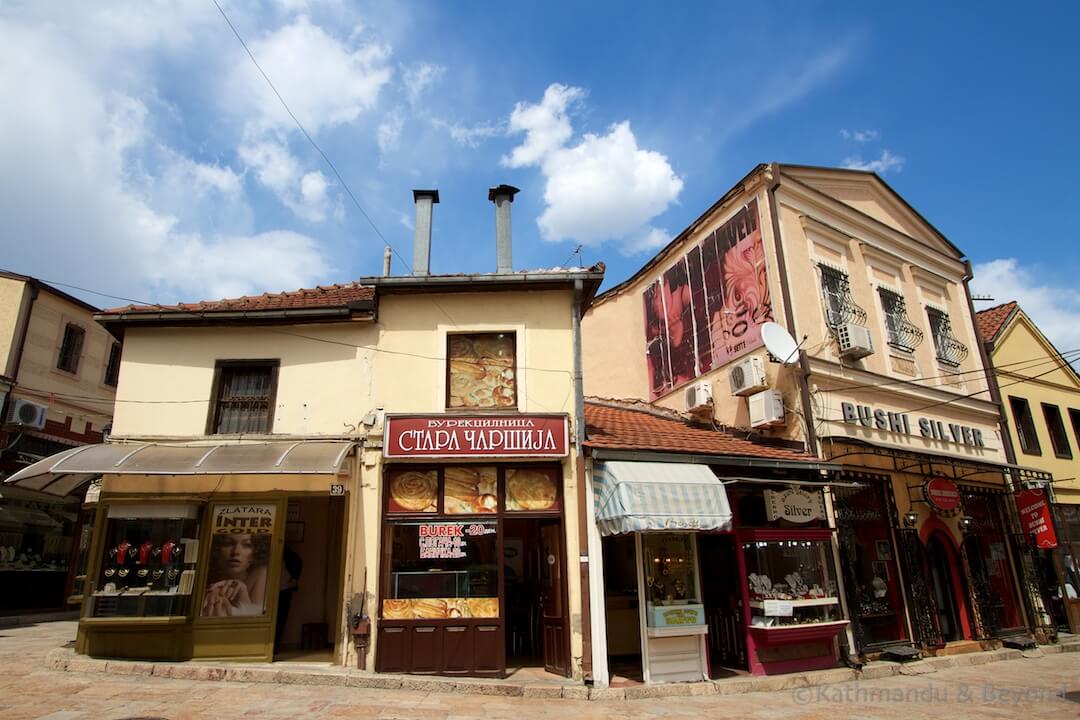 Old Bazaar (Čaršija)
Old Bazaar (Čaršija)
A welcome respite from the grandeur of the river banks, Čaršija is still very much a workaday neighbourhood. Sure, the Old Bazaar has its fair share of tourist-related shops and restaurants but it’s easy to get lost in the backstreets, sip tea in a simple cafe and observe local craftsmen at work.
Heck, you can even still buy a sleeveless sheepskin jacket just like the one Anthony Quinn wore in The Guns of Navarone. If we didn’t travel so light I would have got myself one of those although there is a rumour that my father-in-law (Kirsty’s dad – not pictured by the way, that’s Anthony Quinn!) still has one stored away in the attic somewhere, purchased during his adventures in the Balkans back in the 1960s.
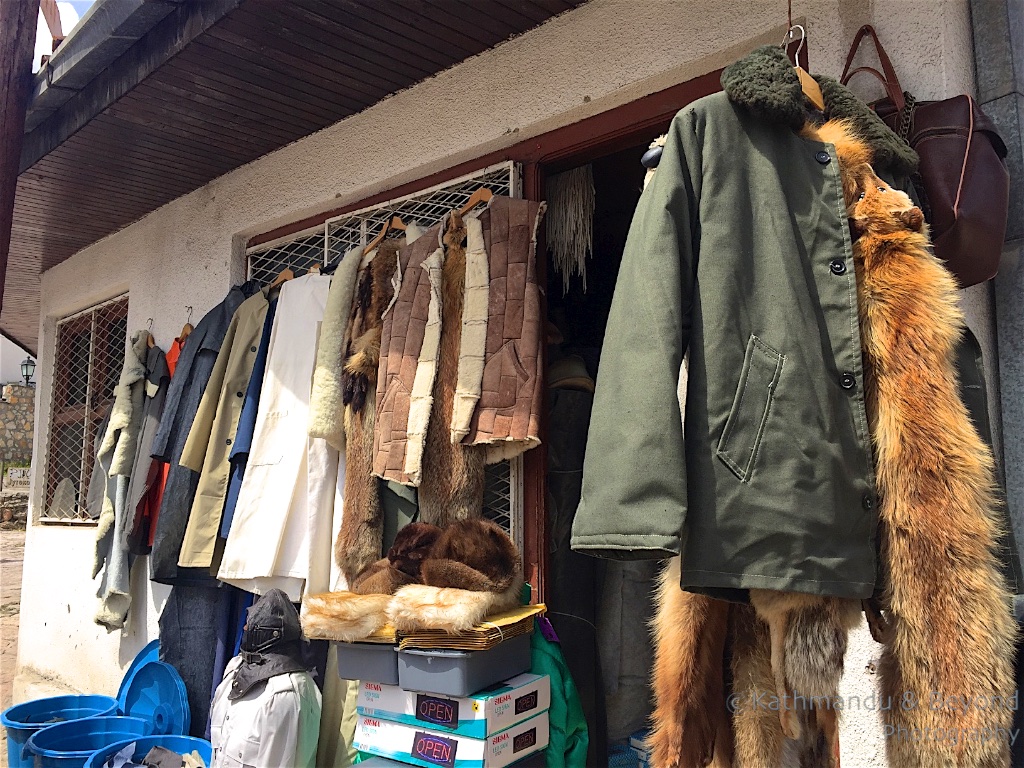
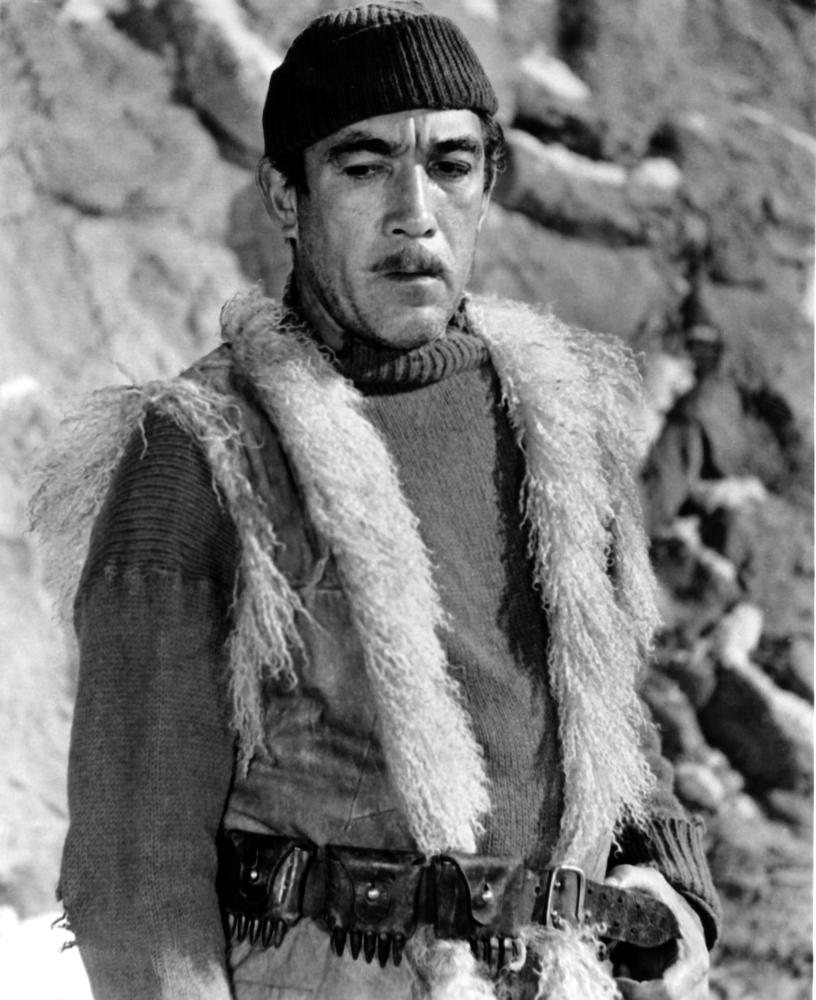
Old Bazaar (Čaršija) (left) and Anthony Quinn in The Guns of Navarone! (right)
The Old Bazaar is mainly about strolling around but if you want a focus, the modern and very hectic Bit Pazar (sometimes called Pit Bazar) at the top end of the district is worth a peek as is Sveti Spas Church where the underground wooden iconostasis (wall of icons and religious paintings) is impressive indeed. But for us, the Mustafa Pasha Mosque was the must-see sight in the Old Bazaar. A fine example of Ottoman architecture, the mosque is situated on the eastern fringes of the bazaar and if you leave it until last, it is only a short (uphill) walk from the mosque to the Tvrdina Kale Fortress. Byzantine and later Ottoman, the city’s castle is not that impressive inside, but it does offer great 360 degree views. You won’t miss the huge National Arena Philip II of Macedonia stadium if you poke your head over the castle’s northern parapet.
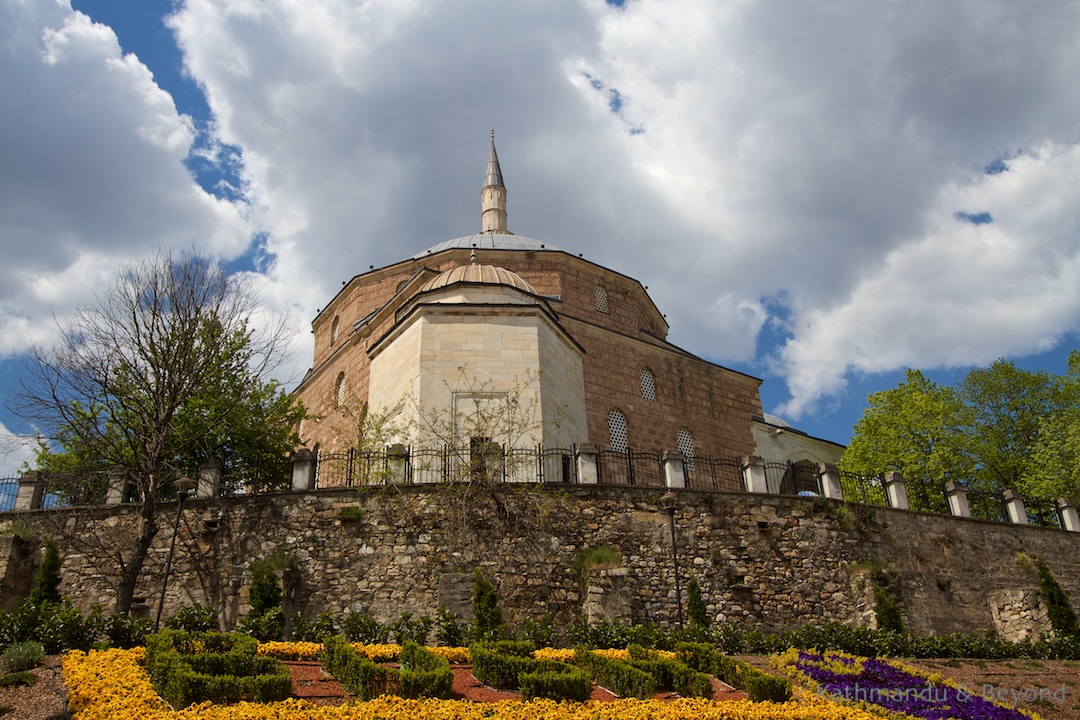 Mustafa Pasha Mosque
Mustafa Pasha Mosque
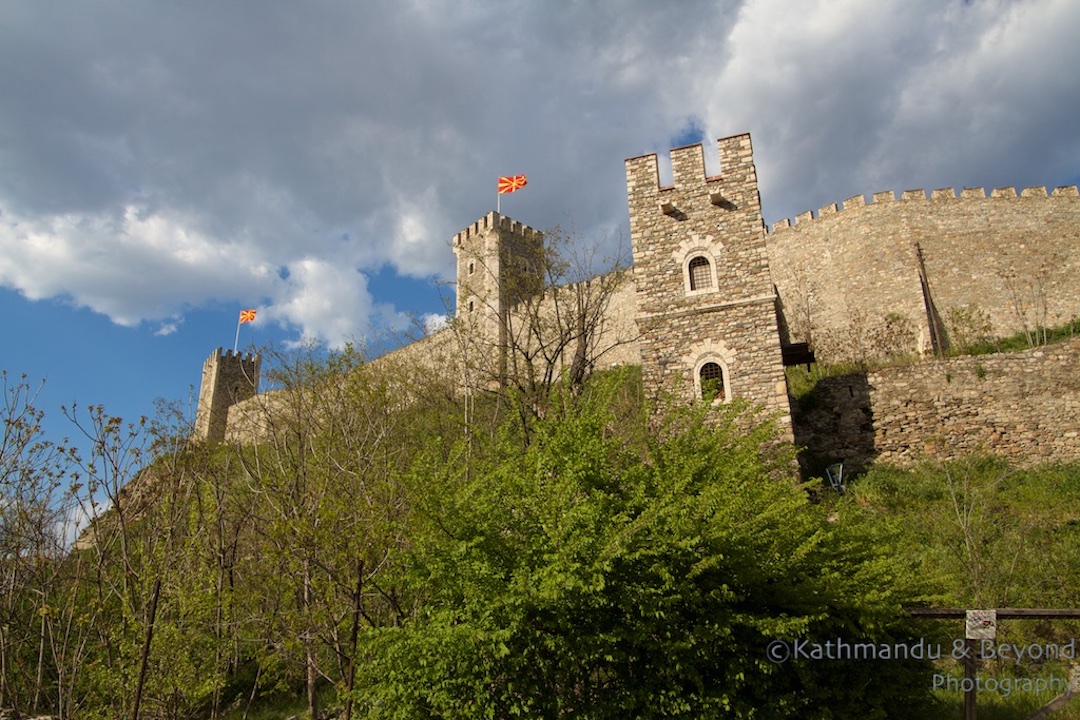 Kale Fortress
Kale Fortress
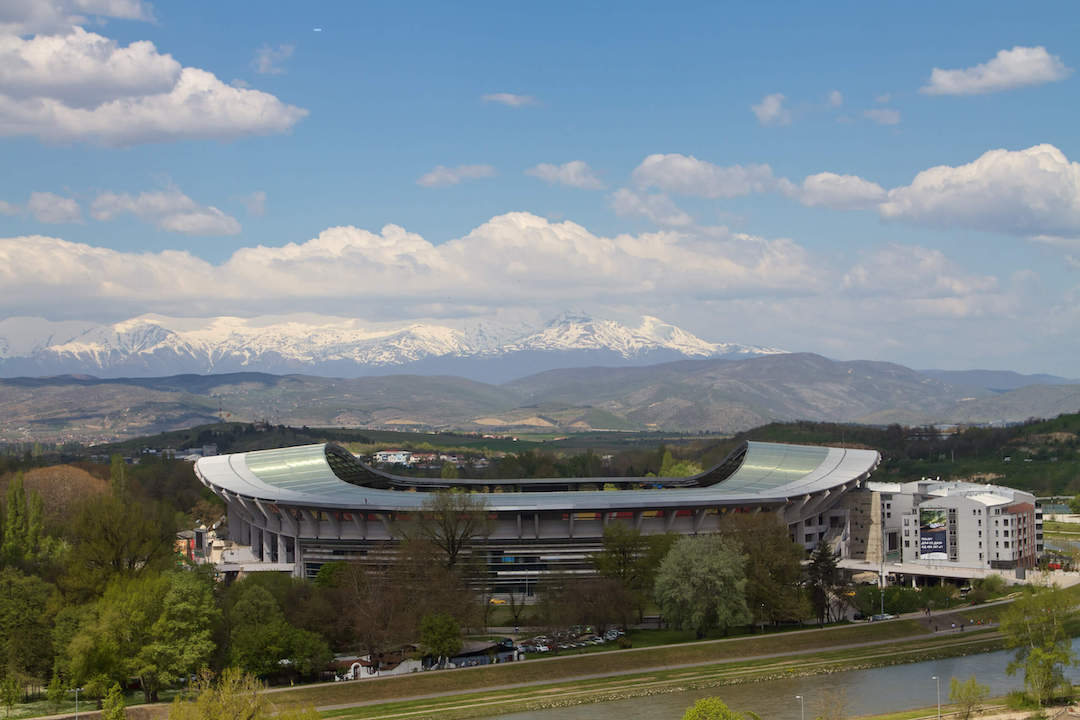 Philip II National Arena
Philip II National Arena
If you head back down to the main road below the fortress and cross the newly renovated (*) Goce Delčev Bridge (check out the lions, one of which was cast in Florence at a cost 1.5 million euros), you can follow the river in a northwesterly direction until you get to the Government of the Republic of Macedonia building. Quite a modest affair in comparison with other city buildings (maybe someone ran out of money?), the government building is very low key security-wise and you can walk right up to the entrance if you are so inclined.
(*) At an estimated cost of 500,000 euros, including 60,000 euros for the new lighting.
Heading back to the film set, I mean the centre of town, the last stop on this walking tour is the picturesque Stone Bridge.
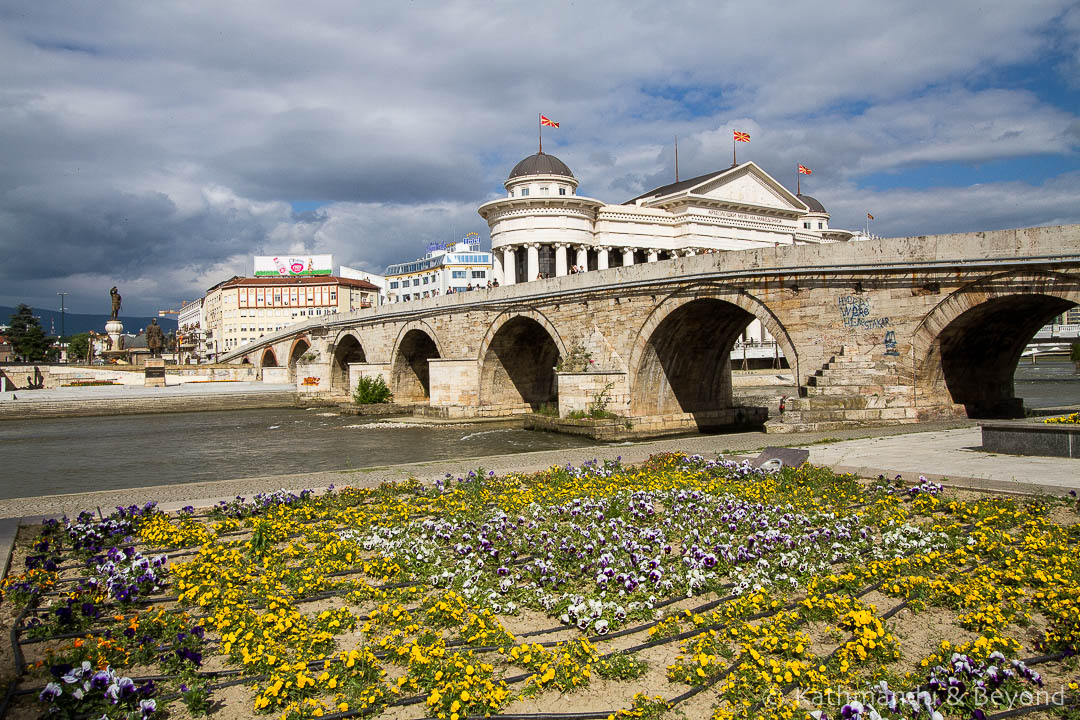 The Stone Bridge
The Stone Bridge
Dating back to Roman times, the bridge is a short distance from the Bridge of Civilisations and is a key design feature in the city’s coat of arms. There’s a great view of the fortress and the ‘ancientness’ on the north bank of the Vardar River from here and also check out the little swimming statue in the river. She disappears and reemerges again depending on the level of the tide. The statue is a nice touch!
Places to see in Skopje away from the city centre
A short distance from the pomp of the city centre, things tend to be a bit more normal. The buildings are like any other regular buildings that you may see in other Balkan cities, the tourists thin out and Skopjeans (I don’t think this is a real word, but I like it!) go about their daily business. It’s nice to just wander around this part of the city, but there are a couple of focal points worth making a beeline for. The Memorial House of Mother Teresa is a short walk southeast of Macedonian Square. You wouldn’t think that this strange looking building (Lonely Planet describe it as a ‘retro-futuristic structure’) was where Mother Teresa spent her formative years but apparently she did and the building is full of MT memorabilia.
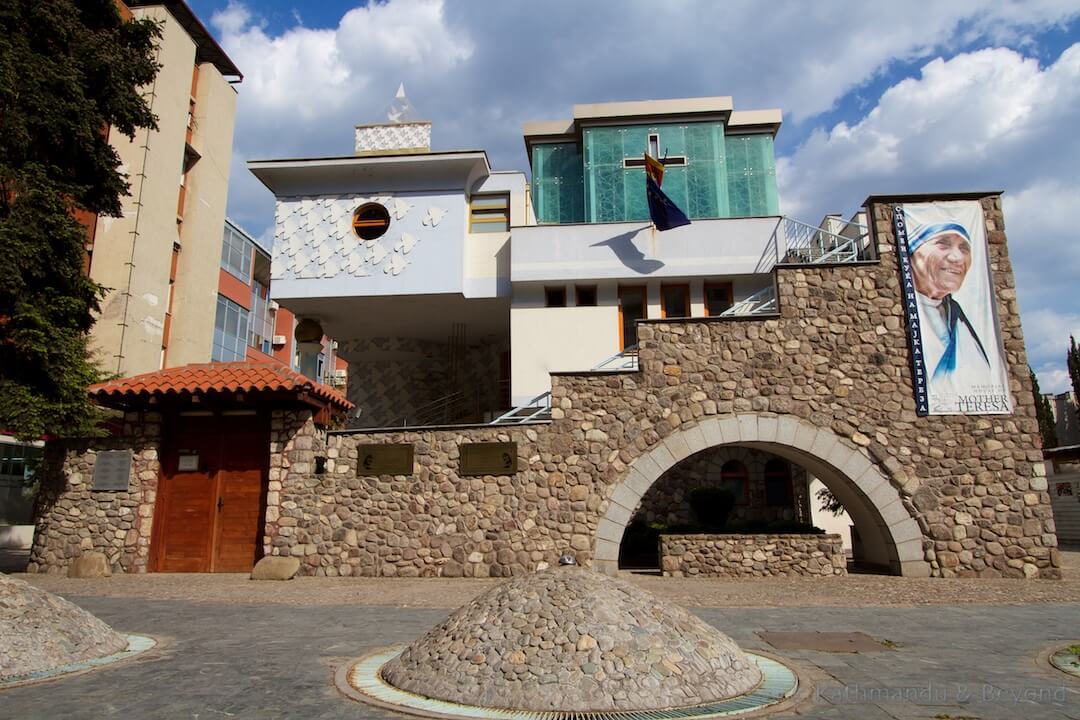 Memorial House of Mother Teresa
Memorial House of Mother Teresa
Keep heading south and you come to the Museum of the City of Skopje. We looked at the outside of the building (an old train station) but didn’t have the energy to go inside yet another museum so I can’t give an opinion of whether it is worth a visit. We did, however, go inside the futuristic-looking Church of St. Clement of Ohrid. Located 1km north of the museum, the church is the largest cathedral of the Macedonian Orthodox Church. It looks like a great big spider (well it did to us anyway!) and from the church, it is a 700-metre walk back to Macedonian Square.
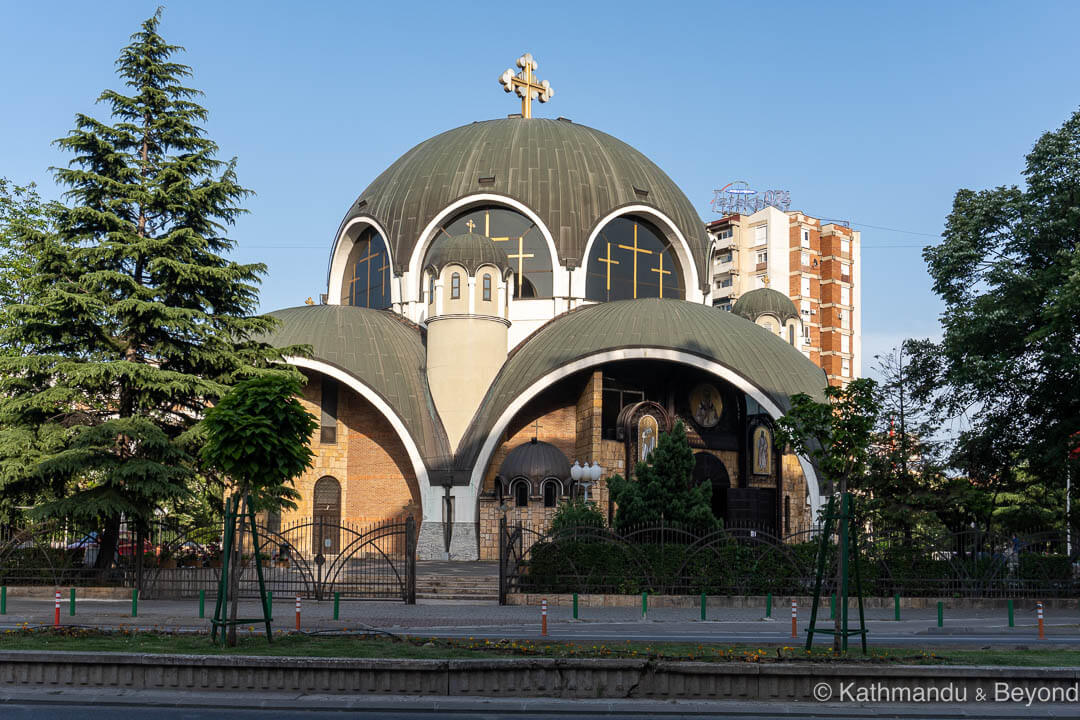 Church of St. Clement of Ohrid
Church of St. Clement of Ohrid
Where to stay in Skopje
We stayed at Modern Living Apartments. They have several apartments available for rent throughout the city. We stayed at the one on Macedonian Square. Along with Studio 15 in Belgrade, it is probably the best apartment we stayed in during our time in Eastern and Southern Europe thus far. We could see Macedonian Square from our kitchen/living room window. We had a separate bedroom, a really nice kitchen/living area, plenty of natural light and it was also nice and peaceful at night. The bathroom could have done with being a bit bigger and the view of Macedonian Square would have been much nicer minus the construction work, but you can’t really blame the apartment owner for that! We paid €30 a night and considered it excellent value for money.
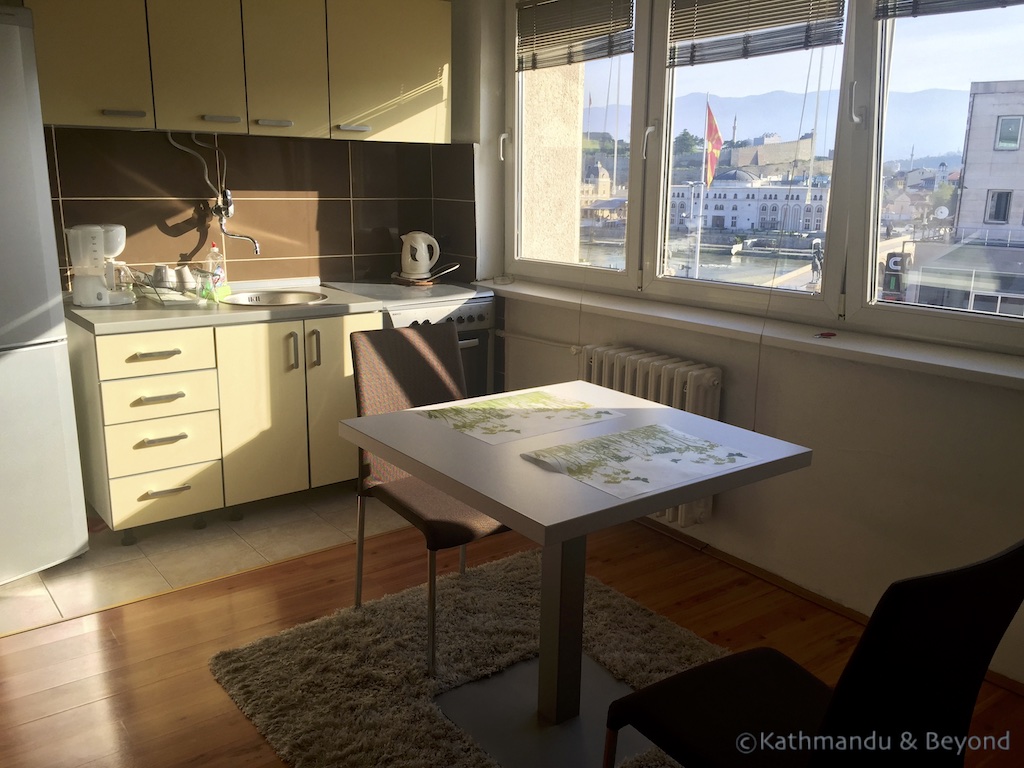
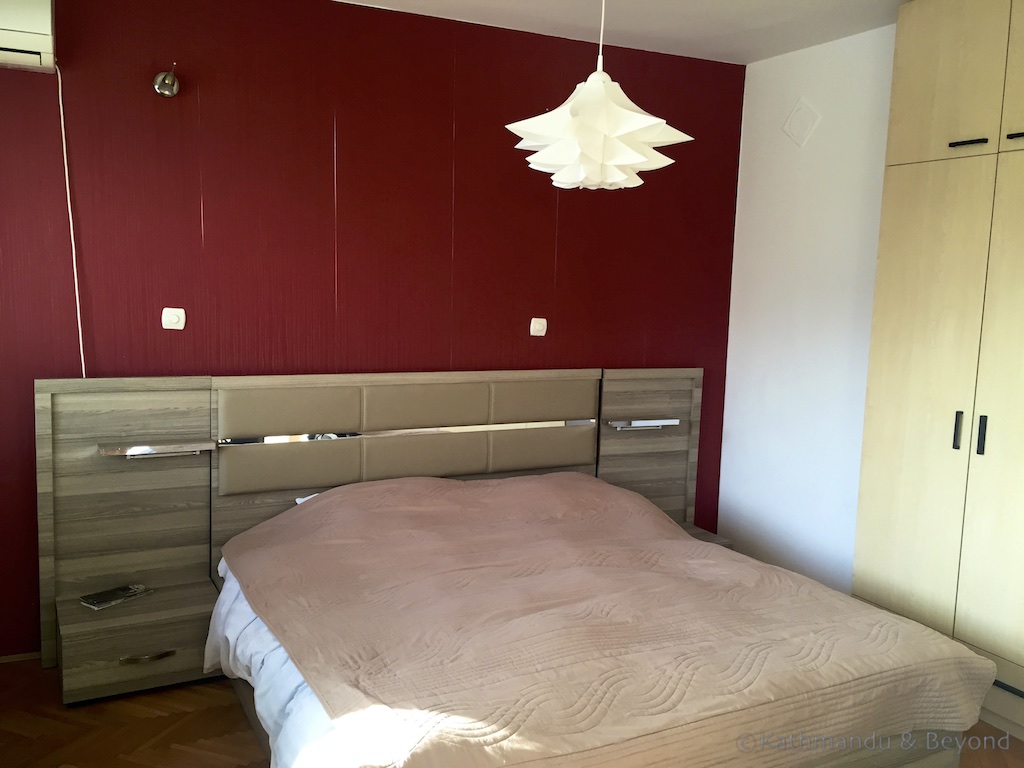
Modern Living Apartment on Macedonia Square
And one final thing
I think we were incredibly lucky with the timing of our visit to Skopje. Although Macedonian Square was sealed off and under its second round of reconstruction, the majority of the buildings and statues that we saw were free of building work. With project work still ongoing (where is the money coming from?) and only a few people in the know about what’s next on the redevelopment agenda (for sure, the nice lady at the tourist board isn’t one of them!), it is tricky to know when to visit. For example, the Government of the Republic of Macedonia building was apparently a mass of scaffolding and nowhere near completion in October 2014. There was no such evidence of this seven months later when we visited. As a word of caution, if you decide to visit Skopje, try and do a little research before committing to dates to ensure you won’t just be wandering around one massive building site for a day or two.
And did you know?
The largest Roma community in Europe is located on the outskirts of Skopje. It is possible to visit, but unfortunately, we didn’t realise it even existed until after we had left the city. For an interesting read on the subject check out The Blonde Gypsy’s post entitled Hanging Out in Shutka – Gypsy Capital of the World.

Good post, we always love the Balkans and Skopje on our list. I like by the way when you list accommodations, very useful for travellers (like us) who travel the same way.
Frank (bbqboy)
Thanks Frank. We don’t always get it right on the accommodation front but in this case we were very pleased with what we found and the location couldn’t have been better. Like most places in this part of the world, you enter the apartment via a dreary ex-Soviet-style block, which even now makes me a little nervous and wonder what on earth have we booked. I remember Kirsty and I giving each other a nervous sideways glance the first time we were lead into such a building (Budapest from memory) but once inside we were pleasantly surprised!
Skopje is almost unrecognizable from what I remember from my 1996 visit. I do remember the old bridge, though. And I think the citadel was in ruins 20 years ago. Do you know if it has been reconstructed?
We can only imagine how much it’s changed! I understand the citadel has been heavily damaged by earthquakes, the most recent one in 1963. I’m pretty sure a lot of the fortress is reconstruction and when we were there archaeologists were excavating the site, which I believe has been ongoing for about 10 years now!
Thank you for the big beautiful pictures, and woah, what a beautiful looking city!
Glad you enjoyed the images and thanks for reading! 🙂 Skopje is a beautiful city – it’s one of the wackiest we’ve visited in terms of architecture, and a lot of it is very over the top. On first sight, we were “Woah, what’s going on here?!” but ultimately we like it a lot.
I have just returned from Skopje and was bowled over by all the architecture. It does seem like a ridiculous OTT waste of money but at the same time it makes the city very compelling for visitors. I loved it so much, I am looking for flights to return.
Yes, it is a crazy amount of money and although a lot of what has been built is very tacky looking, you are right that it is incredibly transfixing. We spent a lot of time, turning corners and saying “What the …” 😉
We’re also looking forward to returning to Skopje at some point. Thanks for reading! 🙂
Skopje …. capital of North Plasticdonia. It looks like most have overlooked the real ‘attraction’ in town… almost all facades of these eclectic buildings are made of Styrofoam! Read the New York Times article -Dancing Nymphs and Pirate Ships: Notes from a Capital of Kitsch- to learn more about the flipside of the megalomania Skopje 2014 project.
That’s crazy! It looks like the only architecture that’s going to last is that created by Kenzo Tange and his team back in the 1960s. In fact, since we wrote this article, we’ve become far more interested in the brutalist and modernist side of Skopje’s architectural heritage rather than the kitsch stuff the city is now more renowned for.